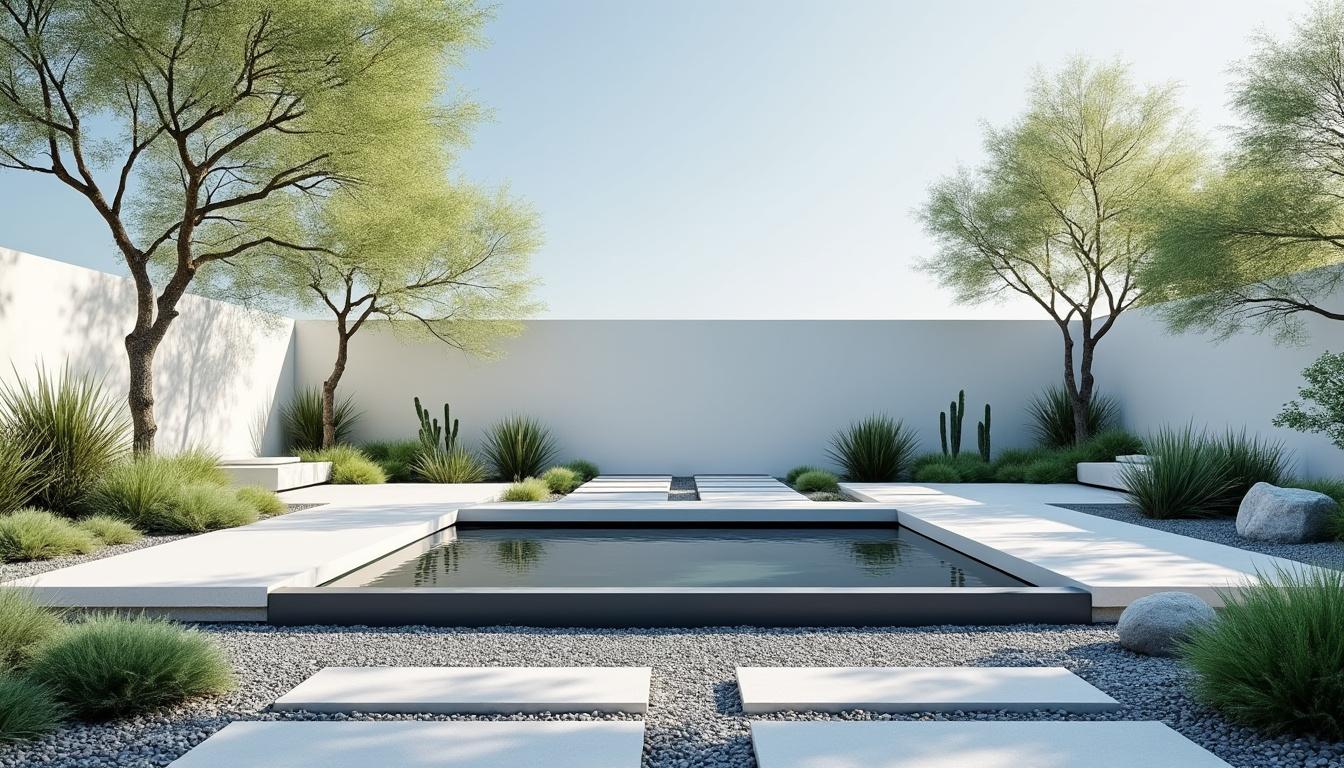Minimalist garden design stands as a testament to the elegance of simplicity, seamlessly melding aesthetic appeal with functional outdoor living. In 2025, gardeners and designers alike embrace a restrained approach, favouring clean lines, muted palettes, and purposeful planting to shape spaces that exude calm and sophistication. Rejecting clutter and complexity, minimalist gardens transform any scale of land — from tight urban courtyards to expansive modern backyards — into serene retreats that resonate with refined luxury.
How To Create A Cohesive Minimalist Garden With A Refined Color Palette
The foundation of a minimalist garden lies in a thoughtfully selected color scheme. Experts endorse limiting colors to maintain unity and tranquility within the space. A palette focused on greens, blues, and whites not only harmonizes with natural surroundings but also guarantees easy plant care by grouping flora with similar requirements.
- Green washed looks: Achieved by layering plants in varied heights and textures within the same color families, enhancing depth without visual noise.
- Single bloom accent: Using white flowers extends garden enjoyment into the evening by attracting night pollinators and highlighting soft twilight ambiance.
- Foliage as accent: Variegated shrubs such as Suntastic ‘Radiance’ Abelia provide subtle leaf color variations that complement blooms and relaxed design.
Planters also play a crucial role; groups of terracotta pots, for example, create warm accents that coordinate with the muted garden tones. Brands like IKEA provide affordable, stylish options to elevate planter aesthetics without compromising on design intent.
| Color Scheme | Plant Type | Benefits |
|---|---|---|
| Green, Blue, White | Lavender, Box hedges, White blooming perennials | Visual calm, harmonious growth conditions, night-time appeal |
| Monochrome Green | Variegated shrubs, Textured grasses | Depth and texture with subtle color shifts |
Material Selection: Streamlined Choices For Minimalist Garden Cohesion
Consistency in garden materials drives the minimalist ethos forward by keeping visual harmony intact. A strict limit to a maximum of three materials will ensure a sharp and polished look. Recommended combinations include:
- Concrete: Durable and understated, perfect for patios and pathways.
- Wood: Adds warmth and organic texture when used in decking or furniture.
- Shingle or Gravel: Offers clean surfaces with functional drainage and contrast.
Overloading the space with additional materials can dilute focus and disrupt the intended simplicity. Integrating renowned brands like Gardena and Bosch ensures quality garden tools and installation accessories that uphold design standards without compromise.
| Material | Use Case | Advantages |
|---|---|---|
| Concrete | Pathways, patios | Longevity, sleek appearance, maintenance ease |
| Wood | Decking, furniture | Natural warmth, visual softness, adaptability |
| Shingle / Gravel | Garden beds, borders | Drainage, texture contrast, minimalist appeal |
Design Strategy: Repetition And Functionality For Timeless Minimalism
Repetition underpins the minimalist aesthetic with rhythm and visual coherence. Incorporating multiple iterations of a single plant or design element strengthens identity and offers a seamless flow. For instance, lining a garden walkway with neatly trimmed boxwoods or Japanese hollies reinforces structure and order.
- Plant repetition: Using uniform species like ‘Soft Caress’ Mahonia creates texture without clutter.
- Functional focal points: Sculptural seating or stone birdbaths serve as both utility and artistic anchors.
- Seamless materials: Employing one consistent hardscape tone maintains aesthetic integrity.
Expert designers recommend furniture and fixtures from Fiskars and Black & Decker for maximizing comfort and durability while sustaining understated elegance in garden features.
| Design Element | Purpose | Effect |
|---|---|---|
| Repeated Topiary/Boxwoods | Outline pathways | Order, rhythm, neatness |
| Stone birdbath or bench | Visual anchor and seating | Functionality with minimalist charm |
| Single tone hardscape | Base material consistency | Visual unity and calmness |
Maintenance Essentials To Protect Minimalist Garden Integrity
Simplicity demands order; maintaining a clutter-free outdoor area is critical. Tools and supplies should be neatly stored in dedicated spaces to avoid visual disruption. Storage solutions from Greenworks, Scotts, and Miracle-Gro provide reliability and ease, ensuring that garden upkeep remains streamlined.
- Store tools in garages or sheds: Utilize versatile storage units to keep implements organized.
- Conceal hoses and accessories: Employ retractable hose reels to minimize unsightly clutter.
- Regular pruning and weeding: Essential to preserving the minimalist look and encouraging plant health.
| Maintenance Task | Recommended Solutions | Benefit |
|---|---|---|
| Tool Storage | Modular storage units, organized shelves | Reduces clutter, efficient access |
| Accessory Concealment | Retractable hose reels, discreet bins | Visual neatness, safety |
| Weeding & Pruning | Routine schedules, ergonomic garden tools | Plant health, minimalist aesthetics |
Optimizing Small Spaces With Minimalist Garden Design Principles
Creating a calm and inviting minimalist garden is possible even in confined areas. By applying a deliberate choice of five plant varieties and a handful of hardscape materials, small patios or atriums transform into tranquil retreats. Thoughtful seating integration, like the addition of contemporary benches from IKEA or Eden Brothers, invites peaceful outdoor moments without overwhelming spatial limitations.
- Selective plant palette: Choose low-maintenance species with sculptural forms and versatile colors.
- Focused hardscape materials: Stick to natural textures such as wood and stone for warmth and contrast.
- Multi-functional seating: Furniture serving as both relaxation and design elements enhances utility.
| Space Type | Key Components | Design Impact |
|---|---|---|
| Small Atrium | Five plant varieties, stone and wood hardscape, bench | Calmness, cohesion, functional retreat |
| Compact Courtyard | Monotone planting palette, consistent materials | Visual spaciousness, minimal clutter |
Professional insights detail how repeating natural elements and maintaining a restrained palette translates to tranquility in any garden scale.
Step-by-step guidance emphasizes the importance of functional features and material consistency, essential for long-lasting minimalist elegance.
Frequently Asked Questions About Creating Minimalist Gardens
- What are the ideal plants for a minimalist garden?
Grasses like carex and miscanthus offer soft movement; clipped topiary spheres provide sculptural appeal; groundcovers such as thyme or dichondra ensure low maintenance. - How many plant varieties should a minimalist garden have?
Experts recommend a restrained palette of three to five varieties to maintain clean lines and simplicity. - What are common pitfalls in minimalist garden design?
Mixing too many textures or materials and selecting high-maintenance plants conflicts with minimalist principles. - Is minimalist gardening suitable for small spaces?
Yes, it is especially effective in compact patios and atriums by applying scale-appropriate planting and material choices. - How does one maintain a minimalist garden?
Regular pruning, weed control, and effective storage of garden tools using brands like Greenworks and Scotts uphold an uncluttered appearance essential to minimalism.

